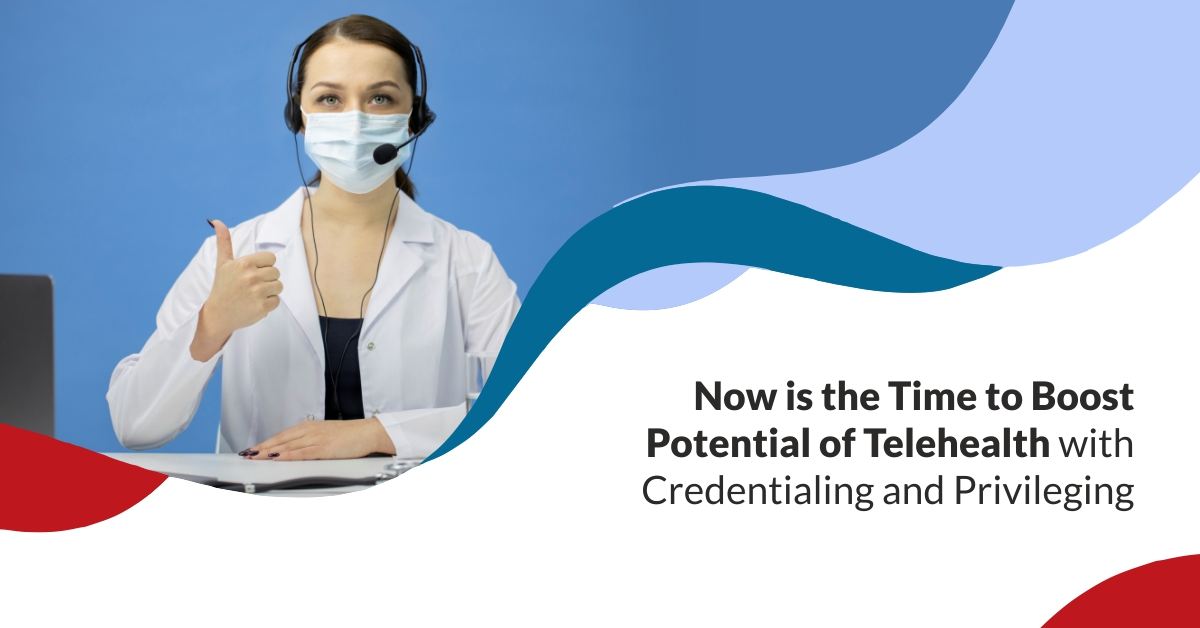
The global demand for telehealth services is expected to double in the next five years, as the industry is likely to reach a valuation of over US$ 55 billion in 2025, according to a research conducted by Markets and Markets. However, telemedicine can only be competent to traditional medicine when a vigorous effort is made to maintain a strict credentialing process for the same.
Though the implementation of advanced technologies such as AI in the healthcare industry is growing, integrating telehealth into a healthcare service program can be complex, considering the time-consuming processes involved in licensing and credentialing. A number of regulations and legal hurdles further add to the complexities, making it a challenging task. Yet, licensing and credentialing is indispensable, and hence, it is essential that these processes are optimized and simplified so that healthcare providers can focus on their core work, which is providing patient care.
Credentialing Telemedicine Providers: The Need of the Time
Telehealth services can help in curbing the spread of multiple diseases, including the coronavirus, and enhance the patient’s and provider’s experience by improving patient-provider connectivity and expanding the reach of healthcare providers. Virtual health service can be a real asset, even post the ongoing pandemic to provide remote healthcare services in rural or war-torn areas and in areas affected by natural calamities.
STAT MedCare empowers healthcare providers to tackle credentialing and licensing issues while integrating telehealth services in their system. Various factors such as growing prevalence of chronic diseases, changing perspective of patients towards virtual healthcare, and revolutionary developments in telehealth amid the COVID-19 crisis, play a huge role in highlighting the importance of licensing, credentialing, and privileging processes. Thereby, this is likely to bolster the potential of growth for telehealth and encourage the adoption of telehealth for the long term.
Changes in Telehealth Regulations make Credentialing even more Important
Implementing credentialing and privileging operations for telehealth has always been a major concern for the healthcare industry. Apart from clinical and operational hurdles, there have also been various legal and regulatory barriers that have thwarted the extensive implementation of licensing and credentialing.
However, with the outbreak of the novel coronavirus, the telehealth industry is witnessing unprecedented growth. Taking into account the effectiveness of telemedicine in the time of such medical emergencies, even the governing bodies are amending their rules and regulations in order to boost advancements in telehealth services.
In March 2020, the Department Of Health and Human Services announced that the government has allowed expansion of telehealth services on a temporary and emergency basis pursuant to waiver authority added under section 1135(b)(8) of the Public Health Service Act by the Coronavirus Preparedness and Response Supplemental Appropriations Act, 2020.
Although the changes in regulations are temporary, they can accelerate long-lasting regulatory developments and further boost growth of the telehealth industry. This will amplify the importance of credentialing, privileging, and licensing for telehealth service providers in order to get benefitted from this condition.
The use of credentialing for telehealth will also help providers to maintain a healthy revenue cycle which will encourage providers to focus on providing their best services to patients, and thrive in the healthcare industry. The telehealth credentialing landscape already had the potential for widespread implementation prior to the COVID-19 outbreak, and with lowered regulatory barriers, it will grow exponentially, thereby ensuring improved patient care and increased revenues for providers.
Telehealth Credentialing is Transforming into a Financially Sound Option
Before the onset of the COVID-19 pandemic, Medicare reimbursements for telehealth services were limited to only a certain number of patients and under a certain set of circumstances. As a result, the utilization of credentialing services prior to the pandemic was quite minimal.
Expansion of Telehealth with 1135 Waiver by the Centers for Medicare & Medicaid Services (CMS) has broadened access to Medicare telehealth services, in order to facilitate beneficiaries to gain access to a wider range of services from their doctors virtually. This has meant providers can provide their services to a much wider range of patients and can maintain a stable source of income even during the pandemic.
Utilizing STAT MedCare’s telehealth services can be a financially sound option for providers to streamline their credentialing processes and generate better revenues. This will let healthcare providers focus solely on treating patients while all the administrative tasks are taken care of.
Modern Credentialing Tools & Technologies can be a Game-Changer
Streamlining credentialing and maintaining licenses are key factors that can help in encouraging the adoption of telehealth. Employing the latest tools and technologies can improve telehealth processes and make the process of provider verification quicker and more accurate. This way, patients can rest assured that they are being treated by licensed and fully credentialed physicians.
While there’s no clear idea about what the post-pandemic world would look like, it has become evident that telehealth will grow at a greater pace and soon become a permanent part of our lives. Utilizing effective tools and technologies can speed up the licensing and credentialing procedures and enable physicians to seamlessly provide patient care.
STAT MedCare can help you to capitalize on the untapped potential of telehealth by optimizing credentialing and other telehealth services. Efficient tools can empower healthcare providers to provide their services without worrying about other administrative hurdles. Modern tools and technologies can thus, improve the credentialing processes of providers and thereby, provide a more efficient healthcare system to patients.
Reach out to us to know how our credentialing services can be beneficial to you and how we can help you to provide optimum healthcare services even during the present uncertain scenario.





